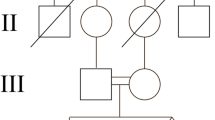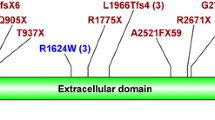Abstract
Aims
Nephronophthisis (NPHP) is an autosomal recessive cystic disease of the kidney with main characteristic features of polyuria/polydipsia, mild or absent proteinuria, interstitial fibrosis, and tubular cysts. NPHP is responsible for 5–10 % of inheritable end-stage renal disease (ESRD) cases. We investigated the clinical features and genetic cause of NPHP in a Persian family with three siblings affected by tubulointerstitial nephropathy reaching ESRD in adulthood.
Methods
Uromodulin (UMOD), known to be involved in adult medullary cystic kidney disease, and nephronophthisis 1 (NPHP1) were investigated in the genomic DNA of the probands using DNA sequencing, multiplex ligation-dependent probe amplification (MLPA) analysis and molecular karyotyping.
Results
No mutation was detected in UMOD. Copy number variation analysis of the NPHP1 gene using the commercially available MLPA kit identified a recurrent large homozygous deletion encompassing all NPHP1 exons. The parents were heterozygous for this deletion. Whole genome array-CGH analysis confirmed a homozygous deletion on chromosome 2q13, NPHP1 site, and revealed that the size of the copy number loss was approximately 102 Kbp.
Conclusion
This is the first report of determination of an NPHP1 deletion size using routine diagnostic methods. The results of this study expand the knowledge about the genotype–phenotype correlations in NPHP1, and have implications for genetic counseling and family planning advice for other affected families. This is the first molecular analysis of NPHP1 in an Iranian kindred.

Similar content being viewed by others
References
Waldherr R, Lennert T, Weber HP, Fodisch HJ, Scharer K (1982) The nephronophthisis complex. A clinicopathologic study in children. Virchows Arch A Pathol Anat Histol 394(3):235–254
Hildebrandt F, Zhou W (2007) Nephronophthisis-associated ciliopathies. J Am Soc Nephrol 18(6):1855–1871. doi:10.1681/ASN.2006121344
Ala-Mello S, Sankila EM, Koskimies O, de la Chapelle A, Kaariainen H (1998) Molecular studies in Finnish patients with familial juvenile nephronophthisis exclude a founder effect and support a common mutation causing mechanism. J Med Genet 35(4):279–283
Blowey DL, Querfeld U, Geary D, Warady BA, Alon U (1996) Ultrasound findings in juvenile nephronophthisis. Pediatr Nephrol 10(1):22–24
Wolf MT, Hildebrandt F (2011) Nephronophthisis. Pediatr Nephrol 26(2):181–194. doi:10.1007/s00467-010-1585-z
Hildebrandt F, Strahm B, Nothwang HG, Gretz N, Schnieders B, Singh-Sawhney I, Kutt R, Vollmer M, Brandis M (1997) Molecular genetic identification of families with juvenile nephronophthisis type 1: rate of progression to renal failure. APN Study Group. Arbeitsgemeinschaft fur Padiatrische Nephrologie. Kidney Int 51(1):261–269
Omran H, Fernandez C, Jung M, Haffner K, Fargier B, Villaquiran A, Waldherr R, Gretz N, Brandis M, Ruschendorf F, Reis A, Hildebrandt F (2000) Identification of a new gene locus for adolescent nephronophthisis, on chromosome 3q22 in a large Venezuelan pedigree. Am J Hum Genet 66(1):118–127. doi:10.1086/302705
Krishnan R, Eley L, Sayer JA (2008) Urinary concentration defects and mechanisms underlying nephronophthisis. Kidney Blood Press Res 31(3):152–162. doi:10.1159/000129648
Zollinger HU, Mihatsch MJ, Edefonti A, Gaboardi F, Imbasciati E, Lennert T (1980) Nephronophthisis (medullary cystic disease of the kidney). A study using electron microscopy, immunofluorescence, and a review of the morphological findings. Helv Paediatr Acta 35(6):509–530
Scolari F, Caridi G, Rampoldi L, Tardanico R, Izzi C, Pirulli D, Amoroso A, Casari G, Ghiggeri GM (2004) Uromodulin storage diseases: clinical aspects and mechanisms. Am J Kidney Dis 44(6):987–999
Christodoulou K, Tsingis M, Stavrou C, Eleftheriou A, Papapavlou P, Patsalis PC, Ioannou P, Pierides A, Constantinou Deltas C (1998) Chromosome 1 localization of a gene for autosomal dominant medullary cystic kidney disease. Hum Mol Genet 7(5):905–911
Scolari F, Puzzer D, Amoroso A, Caridi G, Ghiggeri GM, Maiorca R, Aridon P, De Fusco M, Ballabio A, Casari G (1999) Identification of a new locus for medullary cystic disease, on chromosome 16p12. Am J Hum Genet 64(6):1655–1660. doi:10.1086/302414
Kirby A, Gnirke A, Jaffe DB, Baresova V, Pochet N, Blumenstiel B, Ye C, Aird D, Stevens C, Robinson JT, Cabili MN, Gat-Viks I, Kelliher E, Daza R, DeFelice M, Hulkova H, Sovova J, Vylet’al P, Antignac C, Guttman M, Handsaker RE, Perrin D, Steelman S, Sigurdsson S, Scheinman SJ, Sougnez C, Cibulskis K, Parkin M, Green T, Rossin E, Zody MC, Xavier RJ, Pollak MR, Alper SL, Lindblad-Toh K, Gabriel S, Hart PS, Regev A, Nusbaum C, Kmoch S, Bleyer AJ, Lander ES, Daly MJ (2013) Mutations causing medullary cystic kidney disease type 1 lie in a large VNTR in MUC1 missed by massively parallel sequencing. Nat Genet 45(3):299–303. doi:10.1038/ng.2543
Rampoldi L, Caridi G, Santon D, Boaretto F, Bernascone I, Lamorte G, Tardanico R, Dagnino M, Colussi G, Scolari F, Ghiggeri GM, Amoroso A, Casari G (2003) Allelism of MCKD, FJHN and GCKD caused by impairment of uromodulin export dynamics. Hum Mol Genet 12(24):3369–3384. doi:10.1093/hmg/ddg353
Hart TC, Gorry MC, Hart PS, Woodard AS, Shihabi Z, Sandhu J, Shirts B, Xu L, Zhu H, Barmada MM, Bleyer AJ (2002) Mutations of the UMOD gene are responsible for medullary cystic kidney disease 2 and familial juvenile hyperuricaemic nephropathy. J Med Genet 39(12):882–892
Bollee G, Fakhouri F, Karras A, Noel LH, Salomon R, Servais A, Lesavre P, Moriniere V, Antignac C, Hummel A (2006) Nephronophthisis related to homozygous NPHP1 gene deletion as a cause of chronic renal failure in adults. Nephrol Dial Transplant 21(9):2660–2663. doi:10.1093/ndt/gfl348
Hoefele J, Nayir A, Chaki M, Imm A, Allen SJ, Otto EA, Hildebrandt F (2011) Pseudodominant inheritance of nephronophthisis caused by a homozygous NPHP1 deletion. Pediatr Nephrol 26(6):967–971. doi:10.1007/s00467-011-1761-9
Chaari I, Trabelsi M, Goucha R, Elaribi Y, Kharrat M, Guarguah T, Maazoul F, Chaabouni H, M’Rad R (2012) Prevalence and incidence estimation of large NPHP1 homozygous deletion in Tunisian population. Pathol Biol. doi:10.1016/j.patbio.2012.05.003
Hildebrandt F, Attanasio M, Otto E (2009) Nephronophthisis: disease mechanisms of a ciliopathy. J Am Soc Nephrol 20(1):23–35. doi:10.1681/ASN.2008050456
Soliman NA, Hildebrandt F, Allen SJ, Otto EA, Nabhan MM, Badr AM (2010) Homozygous NPHP1 deletions in Egyptian children with nephronophthisis including an infantile onset patient. Pediatr Nephrol 25(10):2193–2194. doi:10.1007/s00467-010-1539-5
Jiang ST, Chiou YY, Wang E, Lin HK, Lee SP, Lu HY, Wang CK, Tang MJ, Li H (2008) Targeted disruption of Nphp1 causes male infertility due to defects in the later steps of sperm morphogenesis in mice. Hum Mol Genet 17(21):3368–3379. doi:10.1093/hmg/ddn231
van Gravesande KS, Omran H (2005) Primary ciliary dyskinesia: clinical presentation, diagnosis and genetics. Ann Med 37(6):439–449. doi:10.1080/07853890510011985
Torra R, Sarquella J, Calabia J, Marti J, Ars E, Fernandez-Llama P, Ballarin J (2008) Prevalence of cysts in seminal tract and abnormal semen parameters in patients with autosomal dominant polycystic kidney disease. Clin J Am Soc Nephrol 3(3):790–793. doi:10.2215/CJN.05311107
Alazami AM, Alshammari MJ, Baig M, Salih MA, Hassan HH, Alkuraya FS (2014) NPHP4 mutation is linked to cerebello-oculo-renal syndrome and male infertility. Clin Genet 85(4):371–375. doi:10.1111/cge.12160
Parisi MA, Bennett CL, Eckert ML, Dobyns WB, Gleeson JG, Shaw DW, McDonald R, Eddy A, Chance PF, Glass IA (2004) The NPHP1 gene deletion associated with juvenile nephronophthisis is present in a subset of individuals with Joubert syndrome. Am J Hum Genet 75(1):82–91. doi:10.1086/421846
Tory K, Lacoste T, Burglen L, Moriniere V, Boddaert N, Macher MA, Llanas B, Nivet H, Bensman A, Niaudet P, Antignac C, Salomon R, Saunier S (2007) High NPHP1 and NPHP6 mutation rate in patients with Joubert syndrome and nephronophthisis: potential epistatic effect of NPHP6 and AHI1 mutations in patients with NPHP1 mutations. J Am Soc Nephrol 18(5):1566–1575. doi:10.1681/ASN.2006101164
Cooper GM, Coe BP, Girirajan S, Rosenfeld JA, Vu TH, Baker C, Williams C, Stalker H, Hamid R, Hannig V, Abdel-Hamid H, Bader P, McCracken E, Niyazov D, Leppig K, Thiese H, Hummel M, Alexander N, Gorski J, Kussmann J, Shashi V, Johnson K, Rehder C, Ballif BC, Shaffer LG, Eichler EE (2011) A copy number variation morbidity map of developmental delay. Nat Genet 43(9):838–846. doi:10.1038/ng.909
Riggs ER, Church DM, Hanson K, Horner VL, Kaminsky EB, Kuhn RM, Wain KE, Williams ES, Aradhya S, Kearney HM, Ledbetter DH, South ST, Thorland EC, Martin CL (2012) Towards an evidence-based process for the clinical interpretation of copy number variation. Clin Genet 81(5):403–412. doi:10.1111/j.1399-0004.2011.01818.x
Halbritter J, Porath JD, Diaz KA, Braun DA, Kohl S, Chaki M, Allen SJ, Soliman NA, Hildebrandt F, Otto EA (2013) Identification of 99 novel mutations in a worldwide cohort of 1,056 patients with a nephronophthisis-related ciliopathy. Hum Genet 132(8):865–884. doi:10.1007/s00439-013-1297-0
Acknowledgments
This study was undertaken as part of GENE-ME (a research initiative for investigation of inherited diseases from the Middle-East).
Conflict of interest
None.
Author information
Authors and Affiliations
Corresponding author
Additional information
S. Savaj and H. Haghighi-Kakhki contributed equally to this work and should be considered joint second authors.
Rights and permissions
About this article
Cite this article
Haghighi, A., Savaj, S., Haghighi-Kakhki, H. et al. Identification of an NPHP1 deletion causing adult form of nephronophthisis. Ir J Med Sci 185, 589–595 (2016). https://doi.org/10.1007/s11845-015-1312-7
Received:
Accepted:
Published:
Issue Date:
DOI: https://doi.org/10.1007/s11845-015-1312-7




